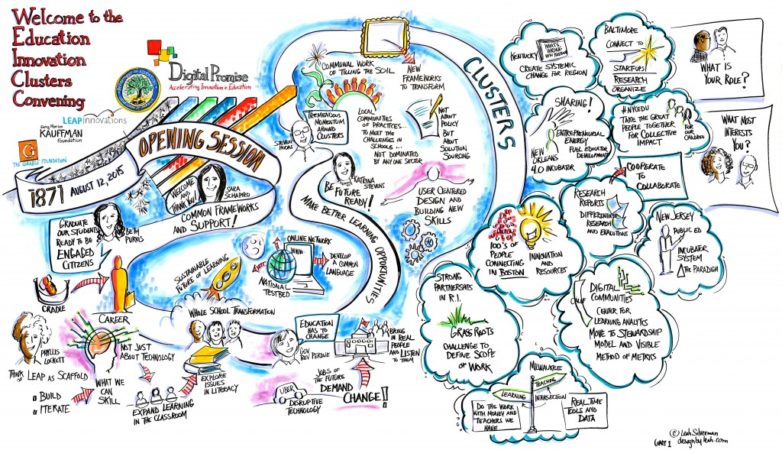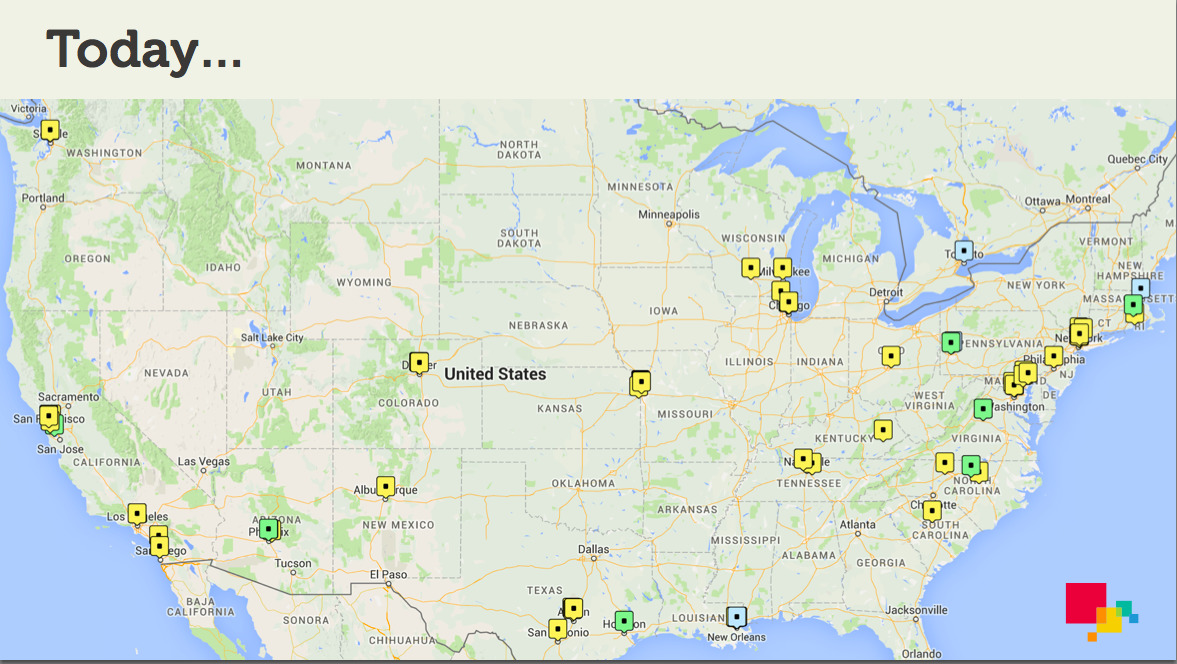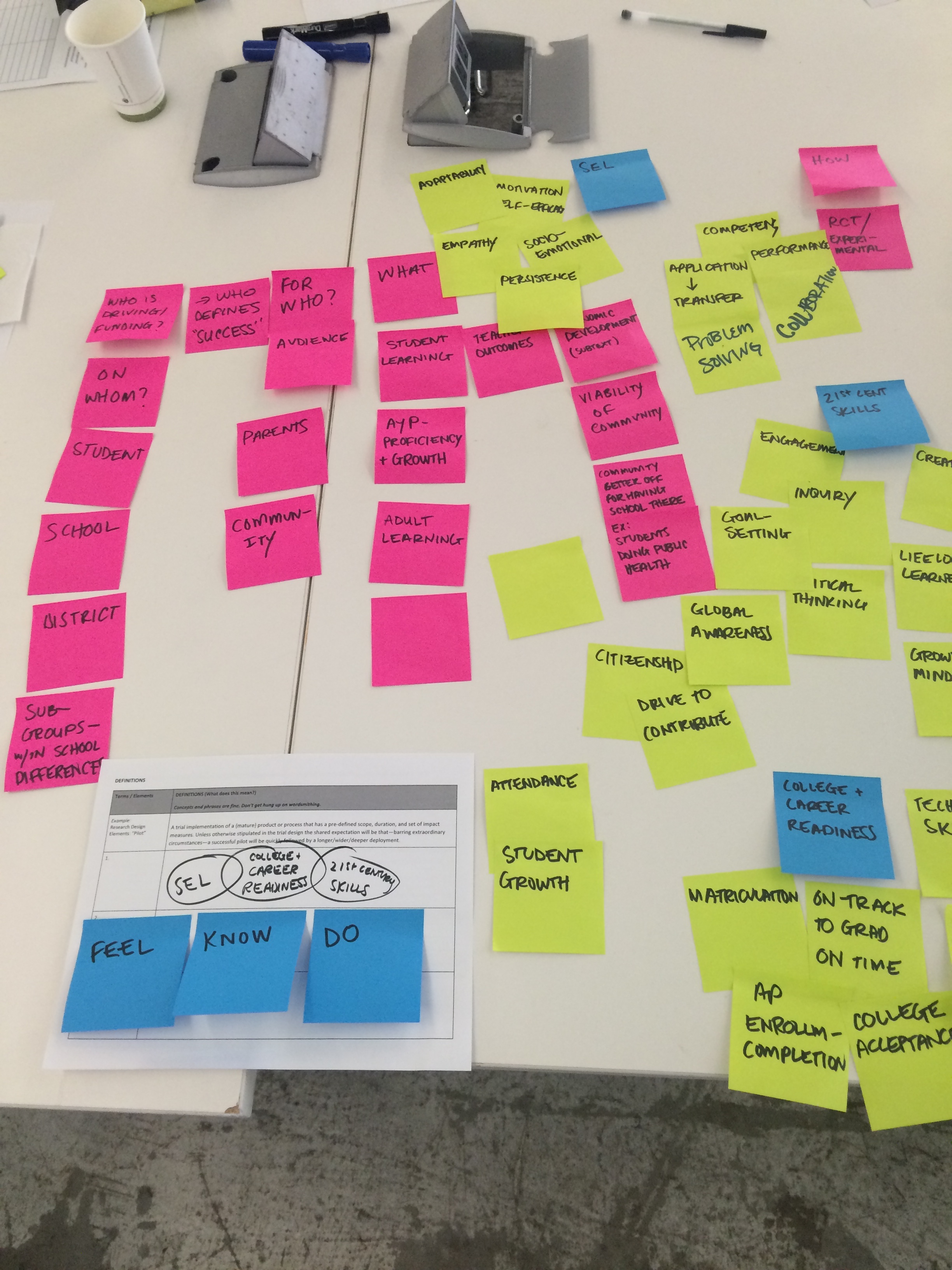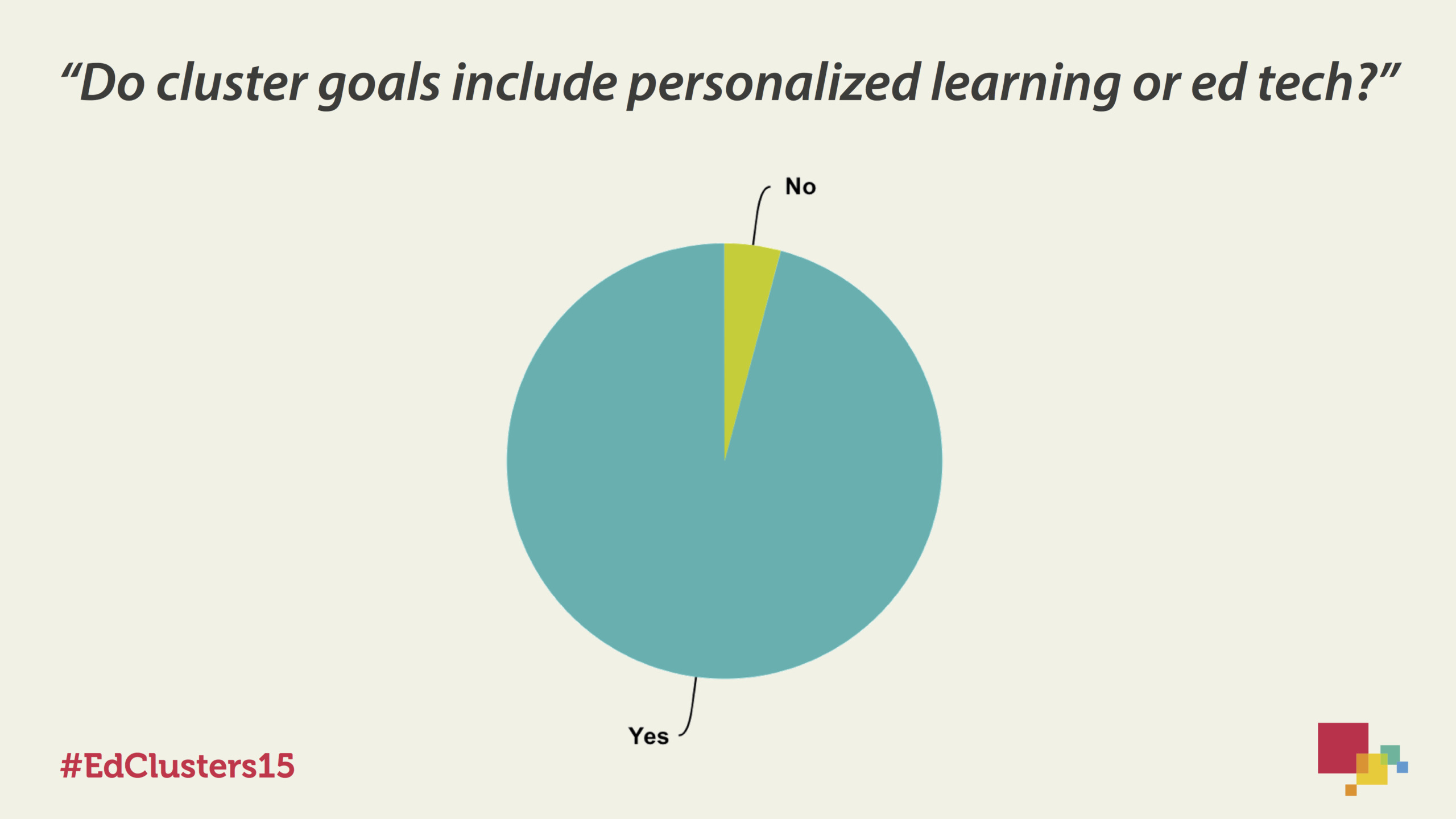

With schools’ technology infrastructure strengthening, the market for education technology solutions growing, and the shift towards personalized learning gaining momentum, the new digital era in schools is approaching. Still, new tools, technologies and practices will fail to make a meaningful difference in students’ lives if they are not developed using collaborative approaches that pull together the insights and perspectives of different sectors.
Communities around the country have taken note, creating “education innovation clusters” that bring together educators, startups, policymakers, investors, researchers, and community groups for powerful collaboration. These grassroots communities of practice enable innovators to cross boundaries, improving the shared understanding of needs and opportunities so that more effective and authentic tools and techniques can be developed to meet 21st century learning challenges.
On August 11th and 12th, Digital Promise and the U.S. Department of Education connected these communities with each other and with national education innovation leaders at the 2015 Education Clusters Convening, hosted by LEAP Innovations at Chicago’s 1871, an entrepreneurial hub for digital startups. Entrepreneurs, investors, non-profits, researchers, funders, policy-makers, and educators from 93 organizations and 34 regions discussed how education innovation clusters can accelerate learning innovations.
Clusters take many forms. They have varying interests, goals, sizes, and ages. Some are in fairly early stages of development, only a few months old, and others have been around for almost a decade.
RT @EdWeekMMolnar: #EdClusters15 is the https://t.co/25WHSjYyRk of education innovation. Meet each other! -Richard Culatta @rec54 #edtech
— Richard Culatta (@rec54) August 11, 2015

Below are some examples of the broad scope and diverse shape of America’s education innovation clusters:
Excited to join @DigitalPromise @OfficeofEdTech & @leapinchicago for #EdClusters15 today @1871Chicago. Let’s @remakelearning, #Pittsburgh!
— Gregg Behr (@greggbehr) August 11, 2015
See @HighlanderInst @ #EdClusters15 RT @tvanderark: Inclusive & Iterative Plan Drives Rhode Island Forward https://t.co/Q8I7mnqhxB #EdPolicy
— Steven Hodas (@stevenhodas) August 5, 2015

There are differences in how these clusters operate, who’s involved, and how long they’ve been active, but all of these regions are working to strengthen the connective tissue of their learning innovation ecosystems, building communities that are better structured to:
Clusters can rally around any number of issues. Most of the convening participants are interested in developing personalized learning solutions, for example. Others are interested in enabling more breakthrough learning moments for kids through hands-on learning opportunities like making. Yet others are interested in creating more innovative professional learning opportunities for teachers.

In breakout sessions, Harrington Park’s Adam Fried, Rowan-Salisbury’s Andrew Smith, NYC iZone’s Kara Chesal, LEAP’s Chris Liang-Vergara, and Digital Harbor’s Andrew Coy explored how clusters can enable more cutting edge learning projects to emerge. The takeaway? There is strength in numbers. There is power in partnerships. And when smart people come together, they can forge new learning pathways that benefit teachers and kids.
We also learned from Digital Harbor’s Andrew Coy, that “you can’t buy a makerspace. You have to make a makerspace.”
A number of conference participants noted the challenge of breaking down silos and connecting people, even in small towns. A number of strategies emerged that can help communities build vibrant learning innovation ecosystems in their town. Participants noted that emerging clusters should:
The essence of clusters is non–traditional collaboration, working with new partners in new ways to develops new habits and toolsets. That’s why we kicked off Wednesday’s session with a panel of diverse perspectives on partnerships, moderated by Mozilla Foundation’s An-Me Chung, and joined by Paul Green from the Kentucky Valley Educational Cooperative, Cambria Skvarka from 4.0 Schools, Shawn Rubin from Rhode Island’s Highlander Institute, and Sarah Luchs from NGLC’s Breakthrough Schools.
Everyone agreed on two things: partnerships are deeply important and great networks aren’t built overnight.
Pittsburgh’s Remake Learning Network, perhaps the most developed cluster in the country, started as a pancake breakfast with just a table full of people. Eight years later, Remake has more than 200 organizations, including more than 2,000 citizens, engaged in their vibrant learning innovation ecosystem. It’s important to keep in mind that it takes time to go from a few pancakes to a few hundred partnerships.
Here are a few interesting ways different folks are facilitating partnerships:
Tips for creating and nurturing partnerships around learning in your region. #edclusters15 pic.twitter.com/LihBB1QIMP
— Digital Promise (@DigitalPromise) August 12, 2015
So what can all this community-building work mean for educators and students in real-world learning environments?
How do schools know what’s worked for others, and how will they know if it’s working for them? One approach to this need for better market information is through discovery and analytics software that present user and editorial reviews, provide lesson–embedded A/B testing of discrete content modules, or allow schools and districts to calculate the learning ROI of their deployments.
In a pre-meeting panel moderated by Sara Allan of the Bill and Melinda Gates Foundation, Karl Rectanus of LearnTrials, Jacob Klein of Motion Math, Elisabeth Stock of PowerMyLearning, and Tanner Higgin of Graphite, discussed the hows and whys of this approach.
“We don’t know what works. Even worse, we don’t know what doesn’t work.”
Karl Rectanus, from LearnTrials
This model turns classrooms and out-of-school learning environments into testbeds, where entrepreneurs, researchers, educators, and students come together to develop and assess ed-tech tools. First launched by the NYC iZone in 2012, school–based ed-tech testbeds have become increasingly popular, leading to rich technology implementation, authentic professional development on design thinking, collaborative product development, and teaching strategies. For software companies, the opportunity to engage with educators in their environments—not as customers but as co–developers—has led to a greater understanding of educators’ real needs and constraints and more responsive products.
Testbeds are ideal cluster projects, either to get the cluster off the ground or as new work for an existing cluster. A panel, moderated by the Bill and Melinda Gates Foundation’s Sara Allan, brought Erin Mote of InnovateEDU, Dr. Adam Fried of Harrington Park School District, and Chris Liang-Vergara of LEAP Innovations together to discuss how this looks on the ground.
“I love data. Like. I love data. A lot.” Definitely love @erinmote passion here at #edclusters15 pic.twitter.com/Uzcxg4YKum
— Mike Baur (@mbaur) August 12, 2015
Visual notes from #edtech test-beds @sara_allan @erinmote @adamdfried #edclusters15 “Come on this journey with us.” pic.twitter.com/XBseJ69rby
— Deborah Chang (@debryc) August 12, 2015
Supporting this work, Katrina Stevens from the U.S. Department of Education announced the release of a “Rapid-Cycle Tech Evaluations” solicitation – to help establish a high standard for low-cost, quick turnaround evaluations of educational technology, to build a technical working group, and to field test rapid-cycle technology evaluations to understand how to improve education technology application in the real world.
Clusters can provide an opportunity to see which products “work,” at least under a particular set of circumstances. But what do we measure? And how? And what do we mean when we say that something “works?” We asked our Director of Research, Aubrey Francisco, to explore these issues along with a group of practitioners who have been thinking hard about these issues, including Kara Chesal of NYC iZone, Dr. Edith Gummer of the Ewing Marion Kauffman Foundation, Kim Jacobson of San Mateo County iZone, and Amy Nowell of LEAP Innovations.
The panelists offered an invigorated and in-depth look at the role of research in education innovation. All agreed that measurement and evaluation is critical, but noted the many complexities and nuances of capturing reliable data. Ultimately, Dr. Gummer may have put it best: “It’s not what works – it’s what works for whom, under what conditions.”
Given that so many of the themes of #EdClusters15 centered on language, we thought it appropriate to close with a working session on developing common terms and vocabularies that would allow clusters around the country and around the world to interoperate with one another. Similar to an “API” to use a software metaphor.
Three groups were each asked to create a preliminary list of terms for different elements of testbeds. For example, when we say that this developer or this school is “ready” to participate in a testbed, what do we mean by “ready”? And what do we mean by “participate” or even by “testbed”? Collaborations represent substantial investments of time and energy and having these kinds of shared understandings at the outset can go a long way towards making sure they return value to everyone involved.
Over the next several months Digital Promise will lead a set of working groups composed of cluster practitioners to continue this effort towards a shared vocabulary.
During lunch, our friends from the Sprout Fund in Pittsburgh demoed the Remake Learning Playbook Gameplan app, which allows anyone to remix their own game plan to start supporting 21st century learning in their community. Now, you can hack the successful Pittsburgh model to see how you can remake learning in your classroom, library, community, or city!
Just launched at #EdClusters15: @remakelearning Playbook https://t.co/X7eWhzukN7 & https://t.co/7d4pkXgXJs pic.twitter.com/O4HoMt9c9X
— Dustin Cory Stiver (@DustinStiver) August 12, 2015
Continuing the tradition of raising one’s hand and committing one’s city to host the next convening of education innovation clusters, Shawn Rubin of the Highlander Institute nominated Providence, Rhode Island. We’re coming for you, Providence.
Chicago Mayor Rahm Emanuel dropped by to add his unique perspective and infamous zeal to the conversation. The Mayor re-emphasized the city’s commitment to this work, and reminded attendees that learning happens everywhere; everyone has a role to play to strengthen learning pathways for kids.
#Gladhandling: @tullman + @RahmEmanuel shaking hands & taking names for education innovation! #Educelerate #edtechdev pic.twitter.com/hkyoNBQlxG
— Christopher Nyren (@CNyren) August 12, 2015
Former North Carolina Governor and Digital Learning Institute Chair and Founder Bev Perdue also spoke to the group, noting that educational technology is poised to transform the education system in a similar way that cars transformed personal commuting.
Richard Culatta, Director of the Office of Educational Technology at the U.S. Department of Education, talked about how much this movement has grown. Culatta confessed that two years ago, he had to work the phones to get people to show up to the first Education Innovation Clusters convening. This year, folks were calling him to ask how they could get an invitation.
Heather Anichini, the President and CEO of the Chicago Public Education Fund reminded attendees that there’s broad support for transforming education, including from a tremendous amount of teachers.
Illinois’ Secretary of Education Dr. Elizabeth Purvis welcomed participants to the great state of Illinois, where we were thrilled to spend two wonderful days engaging with and learning from each other.
And last but not least, Digital Promise President and CEO Karen Cator discussed the potential of clusters as a model to better address grand challenges in education by fostering collaboration, incentivizing action, and catalyzing breakthroughs.
We were delighted to host the third Education Innovation Clusters convening, and we were thrilled to see that so many others enjoyed the event too. Certainly, there was a lot to absorb, especially for those new to this work, but we hope that in the years to come, this field only continues to develop and grow.
Thank you to all of those who attended the convening, and to all of the innovators who are propelling this work forward in communities across the country.
To keep up with our cluster work, please follow us on Twitter @DigitalPromise and subscribe to get updates on clusters. See you in Providence!
well done #edclusters15 & thx to @DigitalPromise & esp @KatrinaStevens1 @stevenhodas for powerful event. here’s to the year of the clusters!
— Remi Holden (@remiholden) August 12, 2015
Excellent takeaways from #EdClusters15, can’t wait to continue the convo in RI at the next convening! pic.twitter.com/vxrpmxo1hO
— Octavia Abell (@octavia_abell) August 12, 2015
On the need for more people in the “Do-Tanks” than “Think Tanks” in education. @DigitalPromise #edclusters15 I like this
— Alicia Herald (@aliciaherald) August 12, 2015